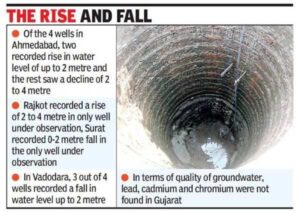AHMEDABAD: A data tabled in the Rajya Sabha recently pointed that Ahmedabad city was found to have groundwater levels at 67 metre (220 feet) in the confined aquifer. At 67 metres, Ahmedabad had the third deepest groundwater aquifer after Jaipur (84.7 metre) and Dehradun (79.2 metre), according to RS data. To put the figure in perspective, the deepest Delhi’s level was at 64 metres, 53.6 metre in Chandigarh and 45.8 metre in Lucknow.

Other Gujarat cities fared better with the deepest levels at 12.3 metre in Vadodara, 5.5 metre in Rajkot and 4.6 metre in Surat. The data was collected from four wells in Ahmedabad and Vadodara each, and one well in Rajkot and Surat each.
The RS data also pointed that in the phreatic aquifer (below the water table area), the minimum level where water was found in Ahmedabad was found to be 2.2 metre (7 feet) below ground level and maximum 24.7 metre (81 feet) in three wells dug by the experts from Central Groundwater Board (CGWB) in November 2020.
Another question related to the groundwater quality revealed that out of 33 districts, 21 had reported salinity in some parts, 22 fluoride, 24 nitrate, 12 arsenic and 10 districts reported iron in the water samples.
Talking on the groundwater scenario in urban areas, Apoorva Oza, CEO of Aga Khan Rural Support Programme (India), said that while majority of the residential societies have tap water supply, they are augmenting it with bore wells.
“The water table is not recharged enough. Earlier we used to have open spaces where the soil would absorb water. But with faced paced development, open spaces have shrunk significantly,” he said. “While the monsoon is still here, we must focus on water conservation. Another way is promoting re-use of water – something which is as high as 93% in countries like Japan.”
Mohan Sharma, executive director, Development Support Center (DSC) said: “The crop intensity has increased in almost every district which is leading to tremendous pressure on ground water sources. The nitrate content has also increased. Of course, various government and cooperative initiatives have resulted in improvement in water tables in several pockets particularly in Saurashtra, south and north Gujarat districts, but this positive change is limited to nearby canals only like Sujalam Sufalam.”
Sharma added that salinity and nitrate is an issue in the majority of coastal districts along with metal or chemical impurities. “The soil quality is also degrading due to continuous use of deep ground water,” said Sharma, adding that in the periphery of Ahmedabad, the groundwater scenario has improved a bit with arrival of Narmada water.
State-based experts said that the majority of the coastal districts have sea ingress issues, and community-level efforts are on to reduce the severity.

This article is written by Parth Shastri, we admire this article and publish the same for the benefit of our stakeholders! Credit to him!
Vardhman Envirotech
India’s Passionate Rain Water Harvesting Company
